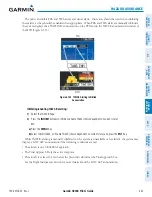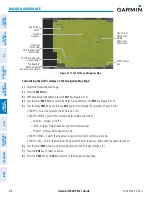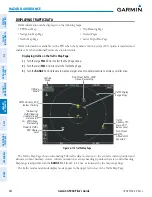
190-00726-00 Rev. J
Garmin G900X Pilot’s Guide
465
HAZARD AVOIDANCE
SY
STEM
O
VER
VIEW
FLIGHT
INSTRUMENTS
EIS
AUDIO P
ANEL
& CNS
FLIGHT
MANA
GEMENT
HAZARD
AV
OID
ANCE
AFCS
ADDITIONAL
FEA
TURES
APPENDICES
INDEX
6.10 GTS 800/820 TRAFFIC
WARNING:
The GTS 800/820 Traffic Advisory System (TAS) is intended for advisory use only to aid the pilot
in visually acquiring traffic. No avoidance maneuvers should be based solely upon TAS traffic information.
It is the responsibility of the pilot in command to see and maneuver to avoid traffic.
NOTE:
Pilots should be aware of TAS system limitations. TAS systems require transponders of other aircraft
to respond to system interrogations. If the transponders do not respond to interrogations due to phenomena
such as antenna shading or marginal transponder performance, traffic may be displayed intermittently, or
not at all. Aircraft without altitude reporting capability are shown without altitude separation data or climb
descent indication. Pilots should remain vigilant for traffic at all times.
NOTE:
TIS is disabled when TAS installed.
The optional Garmin GTS 800/820 is a Traffic Advisory System (TAS). It enhances flight crew situational
awareness by displaying traffic information for transponder-equipped aircraft. The system also provides visual
and aural traffic alerts including voice announcements to assist in visually acquiring traffic.
The GTS 800/820 is capable of tracking up to 45 intruding aircraft equipped with Mode A or C transponders,
and up to 30 intruding aircraft equipped with Mode S transponders. A maximum of 30 aircraft with the highest
threat potential can be displayed simultaneously. No TAS surveillance is provided for aircraft without operating
transponders.
THEORY OF OPERATION
When the GTS 800/820 is in Operating Mode, the unit interrogates the transponders of intruding aircraft
while monitoring transponder replies. The system uses this information to derive the distance, relative bearing,
and if reported, the altitude and vertical trend for each aircraft within its surveillance range. The GTS 800/820
then calculates a closure rate to each intruder based on the projected Closest Point of Approach (CPA). If the
closure rate meets the threat criteria for a Traffic Advisory (TA), the system issues visual and aural alerts.
TAS SURVEILLANCE VOLUME AND SYMBOLOGY
The GTS 800/820 TAS surveillance system monitors the airspace within ±10,000 feet of own altitude.
Under ideal conditions, the GTS 800 unit scans transponder traffic up to 12 nm in the forward direction; the
GTS 820 scans up to 40 nm in the forward direction. The range is somewhat reduced to the sides and aft of
own aircraft due to the directional interrogation signal patterns. In areas of greater transponder traffic density
or when TCAS II (Traffic Alert and Collision Avoidance System II) systems are detected, the GTS 800/820
automatically reduces its interrogation transmitter power (and therefore range) in order to limit potential
interference from other signals.
In addition, if a 1090 MHz extended squitter transponder is installed, and the traffic system detects airborne
traffic providing 1090 MHz Automatic Dependent Surveillance - Broadcast (ADS-B) information, the system
will display the TAS traffic using the ADS-B symbology shown in Table 6-32.






































